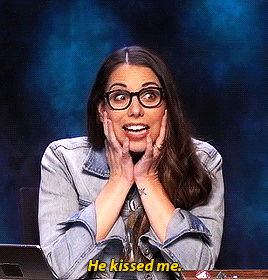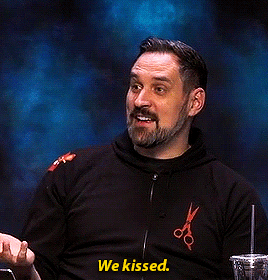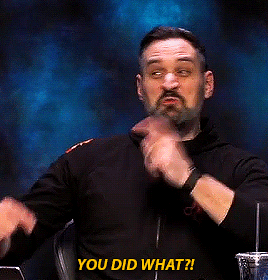ABC Of Bang Yongguk ► Q For Quotes








ABC of Bang Yongguk ► Q for Quotes
More Posts from Larrybell and Others
Tenn: Is this the guy Clem said she’d marry?
James: …
James: Clementine, can I talk to you in private please?
Clem: Sure.
James: I’m gay.

Tiefling horns that grow according to their class send tweet.

Dowoon is the confident icon we all deserve and love. That is all.
Day6 In Three Words
Jae: California chicken boy
Sungjin: He's your dad
Young K: Wild but shy
Wonpil: Walking aegyo machine
Dowoon: Is so done
Cool Tip
If you are like me and always need to be working on something to keep your anxiety under control, during this quarentine why not helping scientists by looking at pictures of some neat penguins? or even galaxies? There’s this site call Zooniverse, where you can help on scientific projects by analyzing pictures and data! Right now my favorite project has returned, called Penguin Watch (where yeah, you get to watch penguins, it’s amazing)

you basically have to analyse photos looking for penguins, their chicks, eggs or even predators and human interaction But there are lots of interesting projects you can help in areas such as biology, physics, history or even art:








Oh and the best part, some institutions even accept it as volunteering/service hour requirements for graduation and scholarships!! It’s helping me a lot during this time, so I thought it was worth sharing








beauyasha + fjorester friend support
The Romantic Poets as people at my apartment complex
Blake: The old guy on the first floor who covers all his windows with newspaper and paints all his terra cotta pots bright red. He’s never spoken to me or anyone else, to my knowledge, but he’s been there longer than anyone. On a different level entirely.
Wordsworth: The next door neighbor with the most beautiful patio in the complex. He’s got all kinds of beautiful plants that are healthy, no matter how much everyone else’s are dying. Very chill, but don’t cross him. Has been here forever and has been known to get salty with the management when a repair takes too long.
Coleridge: That one guy a couple years back who we all thought had died because his mail was piling up outside his door, but as it turned out, he was really just asleep for two whole days (?????) and felt really bad for making everyone worry. Wherever he is, I hope he’s alive.
Byron: That young professional guy who broadly hinted that he had had sex on top of one of the washing machines in the laundry area, but wouldn’t say which one. (He may or may not have been messing with me.) Never seemed to work, but dressed really well and took Ubers everywhere. Actually pretty funny, but I wouldn’t want to go on a trip with him or anything. Sat on the balcony smoking a hookah.
Shelley: The friendly, yet constantly disheveled upstairs neighbor who worked for a local nonprofit and was always playing records at weird hours of the night. Walked very loudly and sang in the shower. Every night at approximately eight o’clock he’d laugh a singular laugh at something (”HA!”) and then he’d go to bed. He was pretty cool, just odd. Down for Nazi-punching.
Keats: That male nurse on the far side of the complex who snuck in a cat a couple years ago and probably has like a squillion of them now. Has one plant that is struggling for survival, but he’s doing his best with it. Always seems nice, but is low key intimidating. Has names for all the raccoons who forage in the dumpsters, and can be seen checking out the furniture that people discard.
Can’t believe it’s been two years...
It’s hard to be positive looking at the state of the kpop industry lately, but hopefully soon our spring will come.
♥ ♥ ♥ You did well, Jonghyun, and you will always be loved ♥ ♥ ♥

I’m writing a book about two characters falling in love while dealing with there different mental health problems. As someone who has mental health problems, I want to be real about it but I’m also scared I’m moving my story too fast. Any tips on how to check if your story is going to fast
The general pacing of story typically relies on the depth of events, which is not to be confused with number of events. They are related, however. You can have:
A story with a lot of events that goes into depth of the events (longer story, slower pace)
A story with a lot of events that does not go into depth (longer story, faster pace)
A story with fewer events that goes into depth of the events(shorter story, slower pace)
A story with fewer events that does not go into depth (shorter story, faster pace)
None of those are necessarily bad, but the kind of story and specific plot the writer has in mind can help determine which place on the + chart that the story should fall. Ideally, the pacing should actually vary per what the event is, but there will still be an overall trend. A story shouldn’t give as much attention to a pit stop as it would to the climax.
Here’s a post on pacing individual scenes. (link embedded)
Checking for pacing can be a little tough, since a lot of the skill comes from general experience with many types of stories, which contributes to knowing how things should be and how to get them there. You ask specifically about checking for a fast pace, so here are some tips, but they are in no way a substitute for a beta reader who has fresh eyes and can give you an objective evaluation:
Look at the word count of your scenes, then look at the context of that word count. If your important scenes have similar word count to the less-important ones, your story may be too fast. Important scenes should naturally have more exploration which would slow them down.
Check to see if you’re telling, not showing, specifically for things that matter. Telling speeds stories up, and while it isn’t always a bad thing since some things need to be summarized, too much can make a story too fast. Showing helps make scenes more vivid and interesting, and naturally slows pacing because it takes up much more room.
A bit more about show, don’t tell (link embedded)
Three Signs That Mean You’re Telling, Not Showing (link embedded)
Do you have intermediate scenes between major events? Some stories don’t need them, particularity plot-focused ones, but a romance should be more character-focused and therefore should have intermediate scenes.They’re typically less-meaningful scenes than direct plot events, but can help show the depth of characters and help set up major events in the story, particularly if an occurrence needs some form of set-up to make sense and not seem like it’s overly convenient or coming out of nowhere.
Do you have subplots and actual obstacles? Subplots and other obstacles naturally slow down pacing, so a story without them is going to move along very quickly. The key to working well with subplots and obstacles is that they have to tie into the main plot and they actually have to provide struggle for the characters.They are not to be treated as “filler”.
What’s your ratio of dialogue-description-exposition? A well-balanced story is a well-paced one, and dialogue should only be about 40-60% of the story. Any more and it’s very likely that a story would be read too quickly and fail to . D-D-E should be interwoven throughout a story and each scene.
Can you picture the scene with what you write? Related to the previous point, description helps give the reader a mental image of what’s happening. Only read what you’ve written, not how you imagined the scene to play out, then evaluate if you can properly envision the setting, characters, and occurrences. Not enough description often means too fast of a pace.
Good luck with your pacing!
Thinking of asking a question? Please read the Rules and Considerations to make sure I’m the right resource, and check the Tag List to see if your question has already been asked.








kinnporsche in a nutshell (insp.)
-
 wrongcow reblogged this · 3 weeks ago
wrongcow reblogged this · 3 weeks ago -
 wrongcow liked this · 3 weeks ago
wrongcow liked this · 3 weeks ago -
 ithadtobeyouforever reblogged this · 3 weeks ago
ithadtobeyouforever reblogged this · 3 weeks ago -
 happycoincidences liked this · 3 years ago
happycoincidences liked this · 3 years ago -
 everynowandchan reblogged this · 5 years ago
everynowandchan reblogged this · 5 years ago -
 artlovsthings liked this · 5 years ago
artlovsthings liked this · 5 years ago -
 baptub reblogged this · 5 years ago
baptub reblogged this · 5 years ago -
 take-me---to-wonderland liked this · 6 years ago
take-me---to-wonderland liked this · 6 years ago -
 meayolo reblogged this · 6 years ago
meayolo reblogged this · 6 years ago -
 1ladibug reblogged this · 6 years ago
1ladibug reblogged this · 6 years ago -
 1ladibug liked this · 6 years ago
1ladibug liked this · 6 years ago -
 lvndrmilk liked this · 6 years ago
lvndrmilk liked this · 6 years ago -
 angang-guiyomi liked this · 6 years ago
angang-guiyomi liked this · 6 years ago -
 asstaethics liked this · 6 years ago
asstaethics liked this · 6 years ago -
 laangeleaura liked this · 6 years ago
laangeleaura liked this · 6 years ago -
 baaaaap reblogged this · 6 years ago
baaaaap reblogged this · 6 years ago -
 sic-kgurl-blog reblogged this · 6 years ago
sic-kgurl-blog reblogged this · 6 years ago -
 glitch-gyal liked this · 6 years ago
glitch-gyal liked this · 6 years ago -
 kirisguiltypleasure liked this · 6 years ago
kirisguiltypleasure liked this · 6 years ago -
 u-know-time liked this · 6 years ago
u-know-time liked this · 6 years ago -
 sae103 reblogged this · 6 years ago
sae103 reblogged this · 6 years ago -
 fluffy-yongguk reblogged this · 6 years ago
fluffy-yongguk reblogged this · 6 years ago -
 dreamwish0809 reblogged this · 6 years ago
dreamwish0809 reblogged this · 6 years ago -
 atekuromi liked this · 6 years ago
atekuromi liked this · 6 years ago -
 atekuromi reblogged this · 6 years ago
atekuromi reblogged this · 6 years ago -
 erin9x reblogged this · 6 years ago
erin9x reblogged this · 6 years ago -
 erin9x liked this · 6 years ago
erin9x liked this · 6 years ago -
 b1a4p liked this · 6 years ago
b1a4p liked this · 6 years ago -
 starlight313 liked this · 6 years ago
starlight313 liked this · 6 years ago -
 wombatnoises liked this · 6 years ago
wombatnoises liked this · 6 years ago -
 jongdwaee reblogged this · 6 years ago
jongdwaee reblogged this · 6 years ago -
 jongdwaee liked this · 6 years ago
jongdwaee liked this · 6 years ago

A lil bit of this, a lil bit of that. Brought to you by a queer, drama/Kpop obsessed, dnd loving, health sci uni student who should really be trying to study 😅
79 posts